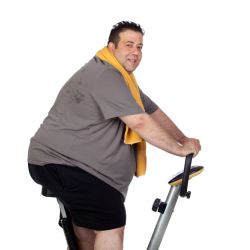As people age we tend to become less active, and are more likely to gain weight. Those two characteristics can lead to lower muscle mass, increasing frailty and associated health problems. Attacking just the weight issue by reducing food intake can certainly be helpful with weight gain, but since weight loss can also decrease muscle mass, it can also contribute to impaired physical fitness and sequelae such as poor balance and diminished strength. So an important question for the older group is what type of exercise — aerobic such as walking, swimming or bike riding, or resistance such as weight lifting — would help the older obese person endeavoring to lose weight? A combination of the two types has been found to be helpful in younger obese people and in non-obese older folks, but would that also be true for obese people 65 and up? A study recently published in The New England Journal of Medicine provides some insight.
Dr. Dennis T. Villareal from the Baylor College of Medicine in Houston, TX and colleagues studied the responses of 160 obese people (BMI > 30) to resistance training, aerobic training or a combination of the two types during a 6-month weight loss regime. Most of the participants were female (over 60 percent) and 90 percent were white. The primary outcome the investigators were interested in was any changes in participants' performances on the Physical Performance Test (PPT). This involved tasks such as putting on and taking off a coat, walking a specified distance, picking up a penny, as well as balance tests — all actions which revealed the extent of deficits in physical functioning and possible degree of frailty. In addition, they examined changes in body weight, peak oxygen consumption (a measure of fitness), and a number of other parameters.
Participants were randomly assigned to one of 4 groups: a control group that had educational sessions on healthful eating but had no exercise intervention; a group that had resistance training; a group that participated in aerobic training; and a group that had both resistance and aerobic training. All the exercise participants had a weight-loss regime that involved a reduction of 500-750 calories per day below usual intake.
After 6 months on their respective regimes, all the groups improved their performance on the PPT, but the improvement was greatest in the combination aerobic and resistance group — 21 percent — significantly greater than any of the other groups. In contrast, the control group's PPT score increased by 4 percent, and the resistance and aerobic groups increased by 14 percent each. All the exercise groups lost a similar amount of weight — 8.5 to 9.0 kgm (19-20 lb), which was a significant difference from their baseline weights. They did not differ from each other, however. And the control group's weight didn't change significantly.
Peak oxygen utilization also increased significantly in the exercise groups, but not in the control group. Further, both the combination and aerobic exercise groups' change in peak oxygen utilization were significantly greater than than that of the resistance group.
These results strongly suggest that, as in younger obese individuals, older ones can benefit from a combination of aerobic and resistance training, even if their weight loss is not different from that seen when using the individual exercise regimes. These results are important, because any improvement in ability to attend to one's own self-care can improve quality of life as well as allow one to maintain a more independent lifestyle as one ages.
Of course, a larger study to confirm these results, and to investigate their generalizability to other populations will be important, but these results should encourage care givers to impress their patients with the importance of attaining and maintaining an active lifestyle.

